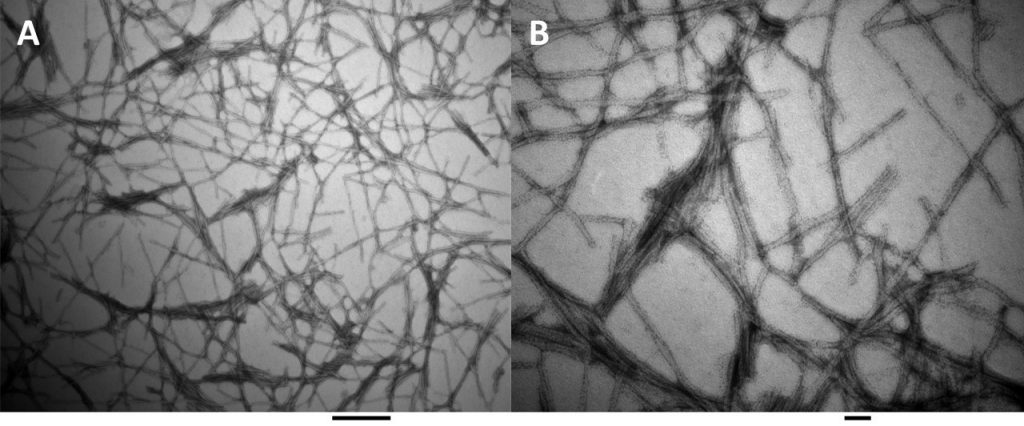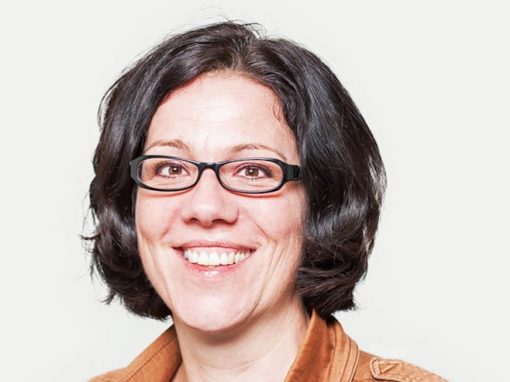P11 – an innovative self assembling peptide for biocompatible hydrogels
The FHNW NanoLab has been working closely with Credentis ag since 2010 (since the company was founded). Credentis ag is mimiking nature with it’s Curolox® Technology to break new ground to keep teeth healthy and protect them. The Curolox® Technology stands for intelligent matrix-forming peptides (self-assembling peptides – SAP). Due to its amino acid sequence, the peptide P11-4 can form a three-dimensional biomatrix (hydrogel) and has a high affinity to hydroxyapatite. Within a caries lesion, the three-dimensional matrix serves as a crystallization nucleus for new hydroxyapatite crystals and thus as a template for new enamel and therefore as a non-invasive treatment of caries lesions [1].

In previous projects, the NanoLab was essentially involved in successfully examining the P11-4 peptide matrix for stability and remineralization potential [2], [3], [4] and thus paving the way for clinical studies. The successful reduction in caries of incipient buccal lesions has been published in several journals ie Nature Scientific Reports [5].
Not only the use of the P11-4 matrix in hard tissue (enamel/ dentin) has proven to be very effective with regard to the remineralization potential, but also the research on soft tissues as part of the PhD thesis (FHNW University Rostock) by F. Koch in the field of periodontal therapy. These very innovative self-assembling peptides (SAPs) open new applications. F. Koch developed a 3D periodontal model as a testing system [6], [7] in which it could been shown that the SAP systems P11-4 and P11-8 have suitable and adaptable fibrillary structures to promote the cell adhesion, growth, and differentiation. SAPs proved to be useful for Human Periodontal Ligament Fibroblasts (HPDLF) to build the bridge from soft to hard tissue in regenerative periodontal therapy. The peptides are being further investigated in this area with regard to their in-vivo potential, e.g. as drug delivery systems for the application of antimicrobial agents in a microbial-rich environment such as the periodontal pocket [8].Due to these properties of SAPs in hard and soft tissue regeneration in the dental field, the research in our NanoLab continues with regard to the generation of so-called hybrid materials. Due to their physicochemical and biochemical properties, these hybrid materials should simulate hard tissue and promote cell migration. Further investigations are ongoing.The regeneration of soft tissue can also entail a completely different application of the SAP-hydrogel: The development of a wound patch.
Hydrogel Patch
Our goal is to develop a hydrogel patch from biocompatible components that can be applied in the oral mucosa. This is intended to protect small injuries in the mouth area and at the same time accelerate their healing.
In the current project in collaboration with credentis ag, the University Centre for Dentistry Basel (UZB) and the Swiss Nanoscience Institute (SNI), the hydrogel is studied to generate a P11-4 hydrogel patch. The SAP P11-4 forms a hydrogel with a three-dimensional network structure in specific environments that are influenced by changes in pH value or ionic strength. By modification of the three-dimensional P11-4 biomatrix, the network structure of the hydrogel has been stabilised to form a hydrogel patch.

Different analytical methods are considered for the characterisation of the hydrogel patch formulation, and potential methods are developed for this purpose. Among others, with nanoindentation micro-mechanical properties of soft material can be evaluated. This allows measuring the stiffness of the P11-4 hydrogel in order to analyse its degree of crosslinking.
Electron microscopy has been used for visual inspection of the P11-4 hydrogel. and made it possible to investigation the modifications of the gel.

[1] Webseite credentis ag: https://www.credentis.com
[2] Kind, L.; Wuethrich, A.; Stevanovic, S.; Pieles, U.; Hug, M.; Lysek, D.A.; A self-assembling peptide with the potential of non-invasive regeneration of early caries lesion; Clin Oral Investig (2013); 17(3).
[3] Kind, L.; Stevanovic, S.; Wuttig, S.; Wimberger, S.; Hofer, J.; Müller, B.; Pieles, U.; Biomimetic Remineralization of Carious Lesions by Self-Assembling Peptide; J Dent Res (2017); 96(7): 790-797.
[4] Koch, F.; Müller, M.; König, F.; Meyer, N.; Gattlen, J.; Pieles, U.; Peters, K.; Kreikemeyer, B.; Mathes, S.; Saxer, S.; Mechanical characteristics of beta sheet-forming peptide hydrogels are dependent on peptide sequence, concentration and buffer composition; R. Soc. open sci. (2018); 5: 171562.
[5] P. Sedlakova Kondelova, A. Mannaa, C. Bommer, M. Adbelaziz, L. Daeniker, E. di Bella, I. Krejci; Efficacy of P11-4 for the treatment of initial buccal caries: a randomized clinical trial; Scientific Reports (2020); 10; 20211.
[6] Koch, F.; Wolff, A.; Mathes, S.; Pieles, U.; Saxer, S.; Kreikemeyer, B.; Peters, K.; Amino acid composition of nanofibrillar self-assembling peptide hydrogels affects responses of periodontal tissue cells in vitro; Int. J. Nanomedicine (2018); 13: 6717-6733.
[7] Koch, F.; Meyer, N.; Valdec, S.; Jung, R.E.; Mathes, S.H.; Development and application of a 3D periodontal in vitro model for the evaluation of fibrillar biomaterials; BMC Oral Health (2020); 20: 148.
[8] Koch, F.; Ekat, K.; Kilian, D.; Hettich, T.; Germershaus, O.; Lang, H.; Peters, K.; Kreikemeyer, B.; A Versatile Biocompatible Antibiotic Delivery system Based on Self-Assembling Peptides with Antimicrobial and Regenerative Potential; Adv. Healthc. Mater (2019); 8(13): 1900167.
Kontakt

Head of nanoLab
FHNW – School of Life Sciences
nanoLab
Hofackerstrasse 30
4132 Muttenz
Switzerland
Comments
No comment posted about P11 – an innovative self assembling peptide for biocompatible hydrogels